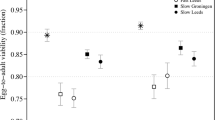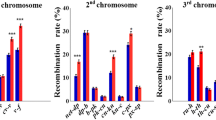Summary
The present investigation describes the effect of selection and of outbreeding and inbreeding on expression of theocelli-less mutant, variable for the number of ocelli and head bristles, inDrosophila subobscura.
Directional selection, in both outbred and inbred populations, was effective in increasing the mean number of ocelli and bristles almost to the wild-type score of 11 in the upward direction, and decreasing the score to 2 in the downward direction, after which no progress was made. The upward selected inbred lines responded to selection more rapidly than the outbred line; the heritability in the inbred lines was found to be more than twice that in the outbred families.
The distribution of phenotypes in the selected populations suggests that the developmental system is such that scores of more than 11 or less than 2 cannot easily be obtained. This bounded nature of the distribution of the phenotypes explains many of the results obtained: in particular, both the variance of the score and the sex difference in score were greatest in populations whose mean score was at the centre of the range, the genetic variance of the score being additive at the centre of the range and epistatic near the bounds.
An attempt was made to pass the upper limit of the score of 11 by selecting at a higher temperature; this attempt was unsuccessful because it was found that progress was opposed by natural selection.
Repeated bristles, extra ocelli and notches in the head were observed in the selected lines; they are interpreted as the extreme responses to selection due to pleiotropic gene effects.
The fitness, as measured by productivity and rate of development in competition with a marker stock, was lower in the inbred than in the outbred populations. The reciprocally selected inbred lines were fitter than the directionally selected lines; there was no corresponding difference in fitness between the various outbred lines.
Similar content being viewed by others
References
Dunn, L. C. andGharles, D. R. (1937). Studies on spotting patterns. I. Analysis of quantitative variations in the pied spotting on the house mouse.Genetics,22, 14–42.
Falconer, D. S. (1953). Selection for large and small size in mice.J. Genet.,51, 470–501.
Harrison, B. J. (1953). Reversal of a secondary sex character by selection.Heredity,7, 153–164.
Lerner, I. M. (1954).Genetic homeostasis. Oliver and Boyd, Edinburgh.
Lerner, I. M. andDempster, E. R. (1951). Attenuation of genetic progress under continued selection in poultry.Heredity,5, 75–94.
MacDowell, E. C. (1915). Bristle inheritance inDrosophila. I. Extra bristles.J. exp. Zool.,19, 61–98.
MacDowell, E. C. (1917). Bristle inheritance inDrosophila. II. Selection.J. exp. Zool.,23, 109–146.
MacDowell, E. C. (1920). Bristle inheritance inDrosophila. III. Correlation.J. exp. Zool.,30, 419–460.
Mather, K. andHarrison, B. J. (1949). The manifold effect of selection.Heredity,3, 1–52; 131–162.
May, H. G. (1917). Selection for higher and lower facet number in the bar-eyed race ofDrosophila and the appearance of reverse mutations.Biol. Bull.,33, 361–395.
Maynard Smith, J., Clarke, J. M. andHollingsworth, M. J. (1955). The expression of hybrid vigour inDrosophila subobscura.Proc. Roy, Soc. B,144, 159–171.
Payne, F. (1918). An experiment to test the nature of the variation on which selection acts.Indiana University Studies,36, 1–45.
Payne, F. (1920). Selection for high and low bristle number in the mutant strain ‘reduced’.Genetics,5, 501–542.
Rasmuson, Marianne (1952). Variation in bristle number ofDrosophila melanogaster.Acta Zool.,33, 277–307.
Rasmuson, Marianne, (1955). Selection for bristle number in some unrelated strains ofDrosophila melanogaster.Acta Zool.,36, 1–49.
Robertson, F. W., andReeve, E. C. R. (1952). Heterozygosity, environmental variation and heterosis.Nature, Lond.,170, 286.
Robertson, F. W. andReeve, E. C. R. (1952). Studies in quantitative inheritance. I. The effects of selection of wing and thorax length inDrosophila melanogaster.J. Genet.,50, 414–448.
Sturtevant, A. H. (1918). An analysis of the effect of selection.Publ. Carnegie Inst. Wash.,246, 1–68.
Tantawy, A. O. (1956). Selection for long and short wing length inDrosophila melanogaster with different systems of mating.Genetica,28, 231–262.
Thoday, J. M. (1953). Components of fitness.Symp. Soc. exp. Biol.,7, 96–113.
Waddington, C. H. (1942). The canalisation of development and inheritance of acquired characters.Nature, Lond.,150, 563–565.
Waddington, C. H. (1953). Genetic assimilation of an acquired character.Evolution,7, 118–126.
Waddington, C. H. (1956). Genetic assimilation of the bithorax phenotype.Evolution,10, 1–13.
Waddington, C. H. (1957). The genetic basis of the ‘assimilated bithorax’ stock.J. Genet.,55, 241–245.
Went, F. W. (1953). Gene action in relation to growth and development. I. Phenotypic variability.Proc. nat. Acad. Sci., Wash.,39, 839–848.
Wright, S. andChase, H. B. (1936). On the genetics of the spotted pattern of the guinea pig.Genetics,21, 758–787.
Zeleny, C. (1922). The effect of selection for eye facet number in the white bar-eye race ofDrosophila melanogaster.Genetics,7, 1–115.
Zeleny, C. andMattoon, E. W. (1915). The effect of selection upon the ‘bar eye’ mutant ofDrosophila.J. exp. Zool.,19, 515–529.
Author information
Authors and Affiliations
Rights and permissions
About this article
Cite this article
Sondhi, K.C. Selection for a character with a bounded distribution of phenotypes inDrosophila Subobscura . J Genet 57, 193–221 (1960). https://doi.org/10.1007/BF02987228
Received:
Issue Date:
DOI: https://doi.org/10.1007/BF02987228




